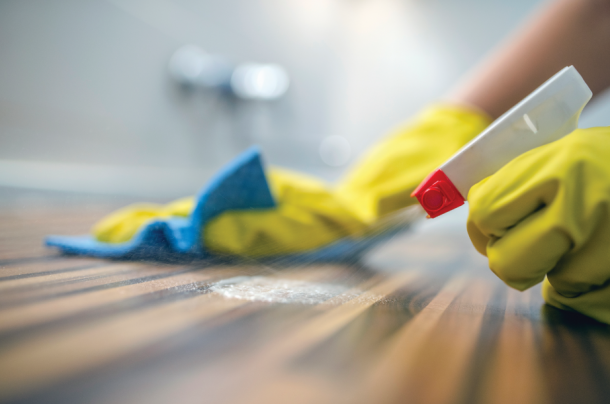
A carpet cleaning company was recently engaged to clean the carpets and upholstery of a small office. Next morning the stains were gone, the colours were vibrant again and everyone was happy. Everyone that is, except one employee.
When this person entered the room, they were smacked with a wall of fragrance so strong, that their throat swelled up, their eyes itched and their head throbbed. Struggling to think through an intense ‘brain fog’, their productivity levels plummeted for the next few days. So, what went wrong?
The true cost of fragranced products
Recent research conducted by Professor Steinemann from Melbourne University, found that 33 per cent of 1098 people randomly surveyed, reported health problems when exposed to fragranced products. Reactions to fragrances can include migraine headaches, dizziness, feeling tired or weak, breathlessness and nausea.
The cost to business, and well as the human cost, is quite staggering. Apart from absenteeism, being subjected to strong fragrances can cause confusion and difficulty with concentration.
Air fresheners and scented cleaning products are known to contribute significantly to indoor pollution. It is also well established that poor indoor air quality (IAQ) results in decreased productivity and may reduce work performance by up to 9 per cent.
Way back in 1998, a CSIRO report put the annual cost of poor IAQ to Australian business at $12 billion. So even if workers are not grabbing for the tissue box or Panadol, their ability to think clearly and stay on task could be diminished by constant exposure to scented products.
Fragrances used in cleaning products and air-fresheners are also linked to some pretty serious health hazards:
Volatile organic compounds (VOCs): VOCs are organic chemicals that can evaporate into the air under normal indoor conditions – allowing them to be easily inhaled and potentially causing a range of respiratory and neurological health problems. In 2011, Steinemann carried out tests on 25 scented cleaning products and found a total of 133 different VOCs in them. Of these, 24 were classified as toxic or hazardous (USA) and only 2 were listed on the MSDS3.
Chemical sensitivity: For people with chemical sensitivities, negotiating public spaces, such as shopping centres, schools, airports, restaurants and restrooms, is like a minefield. Because of the wide-spread use of automated air-freshener mists, plug-in vaporisers and scented hand-soaps, it can virtually be impossible to avoid them. Chemical-sensitivity in a scented world can be totally debilitating.
For those of us with mild chemical sensitivity, it can just be frustrating and embarrassing trying to pull our brain out of the abyss when meeting where scented cleaning products have been used. Because yes – that ‘office worker’ in the introduction is me.
Long term effects: Most people are surprised to learn that some synthetic fragrances (including perfume and aftershave) contain IARC listed carcinogens. However, consumers are kept in the dark because fragrances do not need to be declared on the label or SDS. Steinemann found 44 per cent of the products tested generated at least one of four carcinogenic hazardous air pollutants (acetaldehyde, 1,4-dioxane, formaldehyde, and methylene chloride).
While fragrances may only be a small proportion of a product, when considering the daily cocktail of scents we are exposed to in (air-fresheners, cleaning agents, disinfectants, laundry detergents, hand-soap, deodorant, perfumes and aftershave etc) we really have no idea what the long-term effect will be on our own health, or that of young or unborn children.
Cleaning industry dilemma
The hidden cost of scented cleaning products poses a real dilemma for the cleaning industry. Most people understand the hazards associated with solvents, stain removers, strippers and bleach. But fragrance is usually viewed as a safe and added benefit. In fact, the use of fragranced cleaners and air-fresheners is often demanded by the building users. There is a persistent belief that if they can’t smell a cleaning agent, it hasn’t been cleaned. A bathroom without an air-freshener is considered ‘unhygienic’.
- Yet there is a growing international movement for scent-free environments especially in Canada and the US. Providing scent-free areas if requested by workers with Fragrance Sensitivity, is now a requirement under the ‘Americans with Disabilities Act’ (ADA)4. While there is no such legislation in Australia or New Zealand, a growing awareness about indoor air pollutants, and the adoption of building ratings systems with IAQ criteria such as Green-Star Performance and WELL, means this is a smelly issue that the cleaning industry can no longer ignore.
What you can do about it
Offer a scent-free choice for routine services:
-
- Fragrance-free cleaning agents*
- Altered water technology
- Microfibre with tap water only
Use a cleaning consultant to help you write a cleaning protocol that meets the WELL Criteria. Get educated so you can help your facility manager address the occupant’s belief that fragrance = clean. As I’ve said many times before – clean doesn’t have smell.
Bridget Gardner is the principal director of Fresh Green Clean and can be contacted at bridget@freshgreenclean.com.au